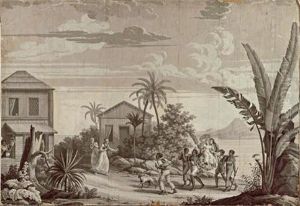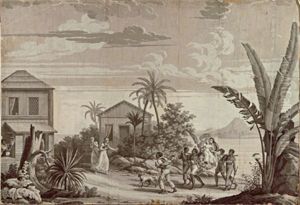Jean Gabriel Charvet Paintings
Jean Gabriel Charvet was a French artist, born in 1750 in Serrières, a small town in the Ardèche region. Charvet is primarily known for his work as a designer of printed textiles during the late 18th and early 19th centuries, a period that witnessed the flourishing of the French textile industry. Despite the fact that he is not as widely recognized as some of his contemporaries, Charvet made significant contributions to the field of decorative arts with his innovative patterns and designs.
Charvet's career as an artist took off when he began working with the famous Manufacture Royale de Beauvais, a prestigious French tapestry manufacturer. It was here that he honed his skills in creating elaborate designs for textiles. He later worked for the Oberkampf factory in Jouy-en-Josas, which was renowned for its printed cotton textiles known as Toiles de Jouy. At Oberkampf, he became one of the principal creators of the vignettes that were featured on the factory’s printed fabrics. These designs often depicted pastoral scenes, classical motifs, and exotic landscapes that became highly fashionable and were sought after throughout Europe.
His most famous work is likely 'Les Travaux de la Manufacture', a series of designs that depict various stages of textile production. These designs were not only artistically significant but also served as an educational tool by providing insight into the manufacturing processes of the time. Charvet's illustrations were characterized by their attention to detail and their ability to capture the intricacies of human labor and industrial processes in a visually appealing manner.
Jean Gabriel Charvet's works were a part of the larger movement of Neoclassicism, which was prevalent in the arts during his time. This movement sought to revive the classical art and architecture of Ancient Greece and Rome, and Charvet's designs often reflected these classical influences in their form and content. Despite his focus on traditional motifs, he was also able to innovate within the genre, adapting and combining elements to create new patterns that were both modern and commercially viable.
Charvet's contribution to the textile industry extended beyond design; he also played a role in the technical advancements of textile printing. He worked during a time when the industry was transitioning from hand-painting fabrics to using copperplate printing, and later, roller printing. Charvet's ability to adapt his designs to these new technologies made him an integral part of the evolution of textile production.
Jean Gabriel Charvet passed away in 1829, leaving behind a legacy that is preserved in the collections of various museums and archives that house examples of Toiles de Jouy. Although personal details of his life are less documented compared to his professional achievements, Charvet’s artistic contributions continue to be recognized by those who study the history of decorative arts and the textile industry.

